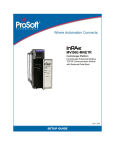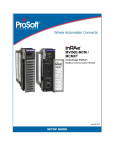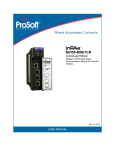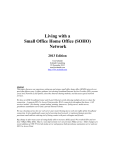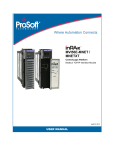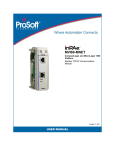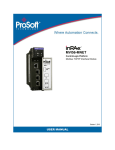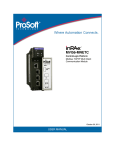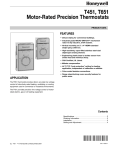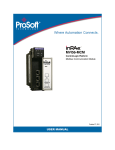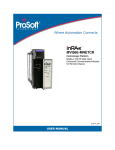Download MVI56E-MNETC Setup Guide
Transcript
MVI56E-MNETC ControlLogix Platform Modbus TCP/IP Multi Client Enhanced Communication Module April 18, 2011 SETUP GUIDE Your Feedback Please We always want you to feel that you made the right decision to use our products. If you have suggestions, comments, compliments or complaints about our products, documentation, or support, please write or call us. How to Contact Us ProSoft Technology 5201 Truxtun Ave., 3rd Floor Bakersfield, CA 93309 +1 (661) 716-5100 +1 (661) 716-5101 (Fax) www.prosoft-technology.com [email protected] Copyright © 2011 ProSoft Technology, Inc., all rights reserved. MVI56E-MNETC Setup Guide April 18, 2011 ® ® ® ® ® ProSoft Technology , ProLinx , inRAx , ProTalk , and RadioLinx are Registered Trademarks of ProSoft Technology, Inc. All other brand or product names are or may be trademarks of, and are used to identify products and services of, their respective owners. ProSoft Technology® Product Documentation In an effort to conserve paper, ProSoft Technology no longer includes printed manuals with our product shipments. User Manuals, Datasheets, Sample Ladder Files, and Configuration Files are provided on the enclosed CD-ROM, and are available at no charge from our web site: www.prosoft-technology.com Important Safety Information North America Warnings A B C Warning - Explosion Hazard - Substitution of components may impair suitability for Class I, Division 2. Warning - Explosion Hazard - When in hazardous locations, turn off power before replacing or rewiring modules. Warning - Explosion Hazard - Do not disconnect equipment unless power has been switched off or the area is known to be nonhazardous. Suitable for use in Class I, Division 2 Groups A, B, C, and D, T5 Hazardous Locations or Non-Hazardous Locations. ATEX Warnings and Conditions of Safe Usage Power, Input, and Output (I/O) wiring must be in accordance with the authority having jurisdiction A Warning - Explosion Hazard - When in hazardous locations, turn off power before replacing or wiring modules. B Warning - Explosion Hazard - Do not disconnect equipment unless power has been switched off or the area is known to be non-hazardous. C These products are intended to be mounted in an IP54 enclosure. The devices shall provide external means to prevent the rated voltage being exceeded by transient disturbances of more than 40%. This device must be used only with ATEX certified backplanes. D DO NOT OPEN WHEN ENERGIZED. Electrical Ratings Backplane Current Load: 800 mA @ 5 Vdc; 3 mA @ 24 Vdc Operating Temperature: 0°C to 60°C (32°F to 140°F) Storage Temperature: -40°C to 85°C (-40°F to 185°F) Shock: 30 g operational; 50 g non-operational; Vibration: 5 g from 10 Hz to 150 Hz Relative Humidity 5% to 95% (without condensation) All phase conductor sizes must be at least 1.3 mm (squared) and all earth ground conductors must be at least 4mm (squared). Markings Agency Applicable Standards RoHS CSA IEC61010 CE EMC-EN61326-1:2006 EN61000-6-4:2007 CSA CB Safety CA/10533/CSA IEC 61010-1 Ed. 2 CB 243333-2056722 (2090408) cULus GOST-R EN61010 ATEX EN60079-0 EN60079-15 243333 E183151 ME06 <cULus> E183151 Class I Division 2 Groups A, B, C, and D Temp Code T5 0°C to +60°C Atex Class I Division 2 Groups A, B, C, and D Temp Code T5 0°C <= Ta <= 60°C Battery Life Advisory Note: Modules manufactured after April 1st, 2011 do not contain a battery. For modules manufactured before that date the following applies: The module uses a rechargeable Lithium Vanadium Pentoxide battery to back up the real-time clock and CMOS settings. The battery itself should last for the life of the module. However, if left in an unpowered state for 14 to 21 days, the battery may become fully discharged and require recharging by being placed in a powered-up ControlLogix chassis. The time required to fully recharge the battery may be as long as 24 hours. Once it is fully charged, the battery provides backup power for the CMOS setup and the real-time clock for approximately 21 days. Before you remove a module from its power source, ensure that the battery within the module is fully charged (the BATT LED on the front of the module goes OFF when the battery is fully charged). If the battery is allowed to become fully discharged, the module will revert to the default BIOS and clock settings. Note: The battery is not user-replaceable or serviceable. MVI56E-MNETC ♦ ControlLogix Platform Modbus TCP/IP Multi Client Enhanced Communication Module Contents Setup Guide Contents Your Feedback Please ........................................................................................................................ 2 How to Contact Us .............................................................................................................................. 2 ® ProSoft Technology Product Documentation .................................................................................... 2 Important Safety Information............................................................................................................... 3 Battery Life Advisory ........................................................................................................................... 4 1 Scope 1.1 1.2 1.3 1.4 2 7 What's New? ............................................................................................................. 8 Learning Objectives ................................................................................................... 9 ProSoft Technology Documentation ....................................................................... 10 Prerequisites ........................................................................................................... 11 Before You Begin 2.1 2.2 2.3 3 System Requirements ............................................................................................. 14 Required Items ........................................................................................................ 15 Sample Files ............................................................................................................ 16 The Sample Application 3.1 3.2 3.2.1 3.3 3.4 4 13 About the MODBUS TCP/IP Protocol ..................................................................... 18 General Overview.................................................................................................... 19 Required Steps ........................................................................................................ 19 Architecture ............................................................................................................. 20 Memory Map ........................................................................................................... 21 Procedures 4.1 4.2 4.3 4.3.1 4.3.2 4.4 4.5 4.6 4.6.1 4.6.2 4.6.3 4.6.4 4.7 4.7.1 4.8 4.8.1 4.8.2 4.9 4.10 ProSoft Technology, Inc. April 18, 2011 17 23 Setting Jumpers ...................................................................................................... 24 Installing the Module in the Rack ............................................................................ 25 Creating a New RSLogix 5000 Project.................................................................... 27 Creating the Module ................................................................................................ 28 Importing the Add-On Instruction ............................................................................ 30 Connecting Your PC to the ControlLogix Processor ............................................... 33 Downloading the Sample Program to the Processor .............................................. 34 Using ProSoft Configuration Builder Software ........................................................ 35 Installing ProSoft Configuration Builder .................................................................. 35 Setting Up the Project ............................................................................................. 36 Uploading the Sample Configuration from the Module ........................................... 38 Enabling the MNET Client 0 Commands ................................................................ 40 Connecting Your PC to the Module ......................................................................... 43 Setting Up a Temporary IP Address ....................................................................... 43 Downloading the Project to the Module .................................................................. 47 Using CIPconnect to Connect to the Module .......................................................... 49 Using RSWho to Connect to the Module ................................................................ 51 Configuring the NOE Ethernet adapter for Modbus TCP/IP (Server) ..................... 53 Connecting the MVI56E-MNETC Module to the Modbus TCP/IP Server ............... 54 Page 5 of 72 Contents Setup Guide MVI56E-MNETC ♦ ControlLogix Platform Modbus TCP/IP Multi Client Enhanced Communication Module 4.11 4.11.1 4.11.2 4.11.3 5 Verifying Communication ........................................................................................ 55 Viewing Exchanged Data ........................................................................................ 55 Checking Module Status through ControlLogix Controller Tags ............................ 58 LED Status Indicators ............................................................................................. 59 Building on Success 5.1 61 Frequently Asked Questions................................................................................... 62 5.1.1 What are the differences between the MVI56 and the MVI56E modules? What does the "E" stand for? ................................................................................................................ 62 5.1.2 What is the difference between the MVI56E-MNET(R) and the MVI56EMNETC(R)? 63 5.1.3 Is the MVI56E product a direct replacement to my existing MVI56 product? ......... 63 5.1.4 How is the MVI56E-MNETC configured? ............................................................... 63 5.1.5 What is ProSoft Configuration Builder (PCB)? ....................................................... 63 5.1.6 What is the purpose of the MVI56E-MNETC Ethernet (E1) Port?.......................... 63 5.1.7 How do I change the module’s IP address? ........................................................... 64 5.1.8 What is the purpose of the Optional MVI56E-MNETC Add-On Instruction? .......... 64 5.1.9 What is ProSoft Discovery Service (PDS)? ............................................................ 64 5.1.10 Does the MVI56E-MNETC module require processor logic? ................................. 64 5.1.11 How do I monitor MVI56E-MNETC operation? ....................................................... 65 5.1.12 Are there any other ways to monitor module diagnostics besides being connected to the module’s network (subnet)? .............................................................................................. 65 Glossary of Terms 67 Index 71 Page 6 of 72 ProSoft Technology, Inc. April 18, 2011 MVI56E-MNETC ♦ ControlLogix Platform Modbus TCP/IP Multi Client Enhanced Communication Module 1 Scope Setup Guide Scope In This Chapter What's New? ........................................................................................... 8 Learning Objectives ................................................................................. 9 ProSoft Technology Documentation ...................................................... 10 Prerequisites ......................................................................................... 11 This document acts as a tutorial, providing step-by-step instructions on how to read and write bi-directional data from one network device to another network device using the MVI56E-MNETC. ProSoft Technology, Inc. April 18, 2011 Page 7 of 72 Scope Setup Guide 1.1 MVI56E-MNETC ♦ ControlLogix Platform Modbus TCP/IP Multi Client Enhanced Communication Module What's New? MVI56E products are backward compatible with existing MVI56 products, ladder logic, and module configuration files already in use. Easily swap and upgrade products while benefiting from an array of new features designed to improve interoperability and enhance ease-of-use. ProSoft Configuration Builder (PCB): New Windows software for diagnostics, connecting via the module's Ethernet port or CIPconnect®, to upload/download module configuration information and access troubleshooting features and functions. ProSoft Discovery Service (PDS): Utility software to find and display a list of MVI56E modules on the network and to temporarily change an IP address to connect with a module's web page. CIPconnect-enabled: Allows PC-to-module configuration and diagnostics from the Ethernet network through a ControlLogix 1756-ENBT EtherNet/IP™ module. Personality Module: An industrial compact flash memory card storing the module’s complete configuration and Ethernet settings, allowing quick and easy replacement. LED Scrolling Diagnostic Display: 4-character, alphanumeric display, providing standard English messages for status and alarm data, and for processor and network communication status. Page 8 of 72 ProSoft Technology, Inc. April 18, 2011 MVI56E-MNETC ♦ ControlLogix Platform Modbus TCP/IP Multi Client Enhanced Communication Module 1.2 Scope Setup Guide Learning Objectives When you have completed all the steps in this Setup Guide, you will have learned how to Understand how the sample application works (page 17) Install the MVI56E-MNETC configuration software Install the MVI56E-MNETC module Import the Add-On Instruction to the processor (page 34) Configure the Modbus TCP/IP Client (page 40) Verify the MVI56E-MNETC module communication status (page 55) ProSoft Technology, Inc. April 18, 2011 Page 9 of 72 Scope Setup Guide 1.3 MVI56E-MNETC ♦ ControlLogix Platform Modbus TCP/IP Multi Client Enhanced Communication Module ProSoft Technology Documentation ProSoft Technology provides the following documentation (manuals) with your MVI56E-MNETC. Documentation, tools, and product support Web Site Support: Visit the ProSoft Technology web site at www.prosoft-technology.com to download additional documentation, tools, and application information. Email Technical Support: Send your support questions to [email protected]. Telephone Support: Please call ProSoft Technology Technical Support at: (Country Code 1+) 661-716-5100. Support is available 24 hours a day, 7 days a week. ProSoft Technology telephone support is free and unlimited. Page 10 of 72 ProSoft Technology, Inc. April 18, 2011 MVI56E-MNETC ♦ ControlLogix Platform Modbus TCP/IP Multi Client Enhanced Communication Module 1.4 Scope Setup Guide Prerequisites To get the most benefit from this setup guide, you should have the following skills: Rockwell Automation® RSLogix™ 5000 software: launch the program, configure and transfer the Add-On Instruction to the processor Microsoft Windows: install and launch programs, execute menu commands, navigate dialog boxes and enter data. Ethernet networking: connect the MVI56E-MNETC module to an Ethernet network using a valid IP address and subnet mask Hardware installation and wiring: install the module and safely connect Modbus TCP/IP Client and ControlLogix devices to a power source and to the MVI56E-MNETC module’s Ethernet port ProSoft Technology, Inc. April 18, 2011 Page 11 of 72 Scope Setup Guide Page 12 of 72 MVI56E-MNETC ♦ ControlLogix Platform Modbus TCP/IP Multi Client Enhanced Communication Module ProSoft Technology, Inc. April 18, 2011 MVI56E-MNETC ♦ ControlLogix Platform Modbus TCP/IP Multi Client Enhanced Communication Module 2 Before You Begin Setup Guide Before You Begin In This Chapter System Requirements ........................................................................... 14 Required Items ...................................................................................... 15 Sample Files.......................................................................................... 16 ProSoft Technology, Inc. April 18, 2011 Page 13 of 72 Before You Begin Setup Guide 2.1 MVI56E-MNETC ♦ ControlLogix Platform Modbus TCP/IP Multi Client Enhanced Communication Module System Requirements The MVI56E-MNETC module requires the following minimum hardware and software components: Rockwell Automation ControlLogix® processor (firmware version 10 or higher), with compatible power supply, and one free slot in the rack for the MVI56E-MNETC module. The module requires 800 mA of available 5 Vdc power Rockwell Automation RSLogix 5000 programming software o Version 16 or higher required for Add-On Instruction o Version 15 or lower must use Sample Ladder, available from www.prosoft-technology.com Rockwell Automation RSLinx® communication software version 2.51 or higher ProSoft Configuration Builder (PCB) (included) ProSoft Discovery Service (PDS) (included in PCB) Pentium® II 450 MHz minimum. Pentium III 733 MHz (or better) recommended Supported operating systems: ® o Microsoft Windows Vista o Microsoft Windows XP Professional with Service Pack 1 or 2 o Microsoft Windows 2000 Professional with Service Pack 1, 2, or 3 o Microsoft Windows Server 2003 128 Mbytes of RAM minimum, 256 Mbytes of RAM recommended 100 Mbytes of free hard disk space (or more based on application requirements) 256-color VGA graphics adapter, 800 x 600 minimum resolution (True Color 1024 × 768 recommended) CD-ROM drive Note: The Hardware and Operating System requirements in this list are the minimum recommended to install and run software provided by ProSoft Technology®. Other third party applications may have different minimum requirements. Refer to the documentation for any third party applications for system requirements. Note: You can install the module in a local or remote rack. For remote rack installation, the module requires EtherNet/IP or ControlNet communication with the processor. Page 14 of 72 ProSoft Technology, Inc. April 18, 2011 MVI56E-MNETC ♦ ControlLogix Platform Modbus TCP/IP Multi Client Enhanced Communication Module 2.2 Before You Begin Setup Guide Required Items This Setup Guide uses a sample application that shows you how to establish communication between the MVI56E-MNETC module (Modbus TCP/IP Client) and a Modbus TCP/IP Server device. The sample application requires the following equipment. Item Description MVI56E-MNETC Modbus TCP/IP Multi Client Enhanced Communication Module 1756-L63 ControlLogix processor 1756-A7/B 1 ControlLogix rack 1756-PA72/B 1 ControlLogix rack power supply CPU434 12A Quantum processor (Modbus device) CPS 114 20 Quantum power supply 140XBP01000 Quantum rack 140NOE77111 NOE Card Ethernet cable Ethernet cable to connect MVI56E-MNETC module to Ethernet network for Modbus TCP/IP communication and diagnostics (supplied with the module) ProSoft Technology, Inc. April 18, 2011 Page 15 of 72 Before You Begin Setup Guide 2.3 MVI56E-MNETC ♦ ControlLogix Platform Modbus TCP/IP Multi Client Enhanced Communication Module Sample Files Note: This procedure requires RSLogix 5000 version 16 (or later), which supports Add-On Instructions. For RSLogix version 15 (or older) applications, please refer to the MVI56E-MNETC User Manual for information on how to use the sample ladder logic. The sample MVI56EMNETC_AddOn_Rung_v1_5.L5X Add-On Instruction file contains all elements required for the MVI56E-MNETC module to function. User-defined Data Types (UDTs) Add-On Instruction (AOI) Ladder rung with AOI Controller tags Item Description MVI56EMNETC_AddOn_Rung_v1_5.L5X Sample rung import file containing Add-On Instruction Copy the file from the ProSoft Solutions CD-ROM, or download them from www.prosoft-technology.com. Save it to a convenient location in your PC, such as Desktop or My Documents. Page 16 of 72 ProSoft Technology, Inc. April 18, 2011 MVI56E-MNETC ♦ ControlLogix Platform Modbus TCP/IP Multi Client Enhanced Communication Module 3 The Sample Application Setup Guide The Sample Application In This Chapter About the MODBUS TCP/IP Protocol .................................................... 18 General Overview.................................................................................. 19 Architecture ........................................................................................... 20 Memory Map ......................................................................................... 21 ProSoft Technology, Inc. April 18, 2011 Page 17 of 72 The Sample Application Setup Guide 3.1 MVI56E-MNETC ♦ ControlLogix Platform Modbus TCP/IP Multi Client Enhanced Communication Module About the MODBUS TCP/IP Protocol MODBUS is a widely used protocol originally developed by Modicon in 1978. Since that time, the protocol has been adopted as a standard throughout the automation industry. The original MODBUS specification uses a serial connection to communicate commands and data between Client and server devices on a network. Later enhancements to the protocol allow communication over Ethernet networks using TCP/IP as a "wrapper" for the MODBUS protocol. This protocol is known as MODBUS TCP/IP. MODBUS TCP/IP is a Client/server protocol. The Client establishes a connection to the remote server. When the connection is established, the Client sends the MODBUS TCP/IP commands to the server. The MVI56E-MNETC module works both as a Client and as a server. Aside from the benefits of Ethernet versus serial communications (including performance, distance, and flexibility) for industrial networks, the MODBUS TCP/IP protocol allows for remote administration and control of devices over a TCP/IP network. The efficiency, scalability, and low cost of a MODBUS TCP/IP network make this an ideal solution for industrial applications. The MVI56E-MNETC module acts as an input/output module between devices on a MODBUS TCP/IP network and the Rockwell Automation backplane. The module uses an internal database to pass data and commands between the processor and the Client and server devices on the MODBUS TCP/IP network. Page 18 of 72 ProSoft Technology, Inc. April 18, 2011 MVI56E-MNETC ♦ ControlLogix Platform Modbus TCP/IP Multi Client Enhanced Communication Module 3.2 The Sample Application Setup Guide General Overview This Setup Guide shows you how to configure the MVI56E-MNETC module and establish communication with a Modbus TCP/IP device (a Quantum processor with a NOE Ethernet adapter, for this example). The MVI56E-MNETC Ethernet application port will be configured as a Modbus TCP/IP (MNET) Client device. The NOE Ethernet adapter will operate as a Modbus TCP/IP Server device, passing data to the Quantum processor. The MVI56E-MNETC will be configured to send two MNET Client commands to the Modbus TCP/IP Server device: Write 10 words (Modbus Function 16 - Preset [Write] Multiple Registers Read 10 words (Modbus Function 3 -Read Holding Registers When you finish the steps in this Setup Guide, you will have enough information to set up your own application. 3.2.1 Required Steps This Setup Guide will take you through the following steps: 1 Install the ProSoft Module in the rack 2 Use the Add-On Instruction to Configure the Module (page 27) 3 Connect your PC to the Processor (page 33) 4 Download the Sample Program to the Processor (page 34) 5 Set up the Sample Application (page 38) a Configure the Modbus TCP/IP Client b Configure the Modbus TCP/IP Client Read Command c Configure the Modbus TCP/IP Client Write Command (page 41, page 42) 6 Transfer the configuration to the module (page 47) 7 Set up the NOE Modbus TCP/IP Server (page 53) 8 Verify Communication (page 55) ProSoft Technology, Inc. April 18, 2011 Page 19 of 72 The Sample Application Setup Guide 3.3 MVI56E-MNETC ♦ ControlLogix Platform Modbus TCP/IP Multi Client Enhanced Communication Module Architecture The sample application uses the following hardware and connections. A Personal Computer running a supported version of Microsoft Windows, with a web browser, RSLogix 5000, ProSoft Discovery Service and an Ethernet port A ControlLogix processor with MVI56E-MNETC module acting as a Modbus TCP/IP Client A Quantum processor with a NOE Ethernet adapter acting as a Modbus TCP/IP Server An Ethernet network connecting the PC with the MVI56E-MNETC, either directly, or through an Ethernet hub or switch. An Ethernet cable connecting the MVI56E-MNETC Modbus TCP/IP Client to the Modbus TCP/IP Server. The following illustration shows the sample application. Note: The illustration does not show the required Ethernet connection for processor programming. Page 20 of 72 ProSoft Technology, Inc. April 18, 2011 MVI56E-MNETC ♦ ControlLogix Platform Modbus TCP/IP Multi Client Enhanced Communication Module 3.4 The Sample Application Setup Guide Memory Map The memory map consists of the starting addresses for Read Data and Write Data areas in the MVI56E-MNETC module and in the Quantum processor. The sample application reads and writes 10 words between the Modbus TCP/IP Client and the Modbus TCP/IP Server. The following table describes the memory map for data transfer between the MVI56E-MNETC module and the Quantum processor. Function MVI56E-MNETC Database Start Address (Client) Quantum Memory Start Word Count Address (Server) Read 1000 400801 10 Write 0 400401 10 ProSoft Technology, Inc. April 18, 2011 Page 21 of 72 The Sample Application Setup Guide Page 22 of 72 MVI56E-MNETC ♦ ControlLogix Platform Modbus TCP/IP Multi Client Enhanced Communication Module ProSoft Technology, Inc. April 18, 2011 MVI56E-MNETC ♦ ControlLogix Platform Modbus TCP/IP Multi Client Enhanced Communication Module 4 Procedures Setup Guide Procedures In This Chapter Setting Jumpers .................................................................................... 24 Installing the Module in the Rack........................................................... 25 Creating a New RSLogix 5000 Project .................................................. 27 Connecting Your PC to the ControlLogix Processor.............................. 33 Downloading the Sample Program to the Processor ............................. 34 Using ProSoft Configuration Builder Software ....................................... 35 Connecting Your PC to the Module ....................................................... 43 Downloading the Project to the Module ................................................. 47 Configuring the NOE Ethernet adapter for Modbus TCP/IP (Server) .... 53 Connecting the MVI56E-MNETC Module to the Modbus TCP/IP Server54 Verifying Communication....................................................................... 55 ProSoft Technology, Inc. April 18, 2011 Page 23 of 72 Procedures Setup Guide 4.1 MVI56E-MNETC ♦ ControlLogix Platform Modbus TCP/IP Multi Client Enhanced Communication Module Setting Jumpers The Setup Jumper acts as "write protection" for the module’s flash memory. In "write protected" mode, the Setup pins are not connected, and the module’s firmware cannot be overwritten. Do not jumper the Setup pins together unless you are directed to do so by ProSoft Technical Support. The following illustration shows the MVI56E-MNETC jumper configuration. Note: If you are installing the module in a remote rack, you may prefer to leave the Setup pins jumpered. That way, you can update the module’s firmware without requiring physical access to the module. Page 24 of 72 ProSoft Technology, Inc. April 18, 2011 MVI56E-MNETC ♦ ControlLogix Platform Modbus TCP/IP Multi Client Enhanced Communication Module 4.2 Procedures Setup Guide Installing the Module in the Rack If you have not already installed and configured your ControlLogix processor and power supply, please do so before installing the MVI56E-MNETC module. Refer to your Rockwell Automation product documentation for installation instructions. Warning: You must follow all safety instructions when installing this or any other electronic devices. Failure to follow safety procedures could result in damage to hardware or data, or even serious injury or death to personnel. Refer to the documentation for each device you plan to connect to verify that suitable safety procedures are in place before installing or servicing the device. After you have checked the placement of the jumpers, insert the MVI56EMNETC into the ControlLogix chassis. Use the same technique recommended by Rockwell Automation to remove and install ControlLogix modules. You can install or remove ControlLogix system components while chassis power is applied and the system is operating. However, please note the following warning. Warning: When you insert or remove the module while backplane power is on, an electrical arc can occur. An electrical arc can cause personal injury or property damage by sending an erroneous signal to your system’s actuators. This can cause unintended machine motion or loss of process control. Electrical arcs may also cause an explosion when they happen in a hazardous environment. Verify that power is removed or the area is non-hazardous before proceeding. Repeated electrical arcing causes excessive wear to contacts on both the module and its mating connector. Worn contacts may create electrical resistance that can affect module operation. ProSoft Technology, Inc. April 18, 2011 Page 25 of 72 Procedures Setup Guide MVI56E-MNETC ♦ ControlLogix Platform Modbus TCP/IP Multi Client Enhanced Communication Module 1 Align the module with the top and bottom guides, and then slide it into the rack until the module is firmly against the backplane connector. 2 3 With a firm, steady push, snap the module into place. Check that the holding clips on the top and bottom of the module are securely in the locking holes of the rack. Make a note of the slot location. You must identify the slot in which the module is installed in order for the sample program to work correctly. Slot numbers are identified on the green circuit board (backplane) of the ControlLogix rack. Turn power ON. 4 5 Note: If you insert the module improperly, the system may stop working or may behave unpredictably. Page 26 of 72 ProSoft Technology, Inc. April 18, 2011 MVI56E-MNETC ♦ ControlLogix Platform Modbus TCP/IP Multi Client Enhanced Communication Module 4.3 Procedures Setup Guide Creating a New RSLogix 5000 Project 1 Open the FILE menu, and then choose NEW. 2 3 4 5 6 Select your ControlLogix controller model. Select REVISION 16. Enter a name for your controller, such as My_Controller. Select your ControlLogix chassis type. Select SLOT 0 for the controller. ProSoft Technology, Inc. April 18, 2011 Page 27 of 72 Procedures Setup Guide MVI56E-MNETC ♦ ControlLogix Platform Modbus TCP/IP Multi Client Enhanced Communication Module 4.3.1 Creating the Module 1 Add the MVI56E-MNETC module to the project. In the Controller Organization window, select I/O CONFIGURATION and click the right mouse button to open a shortcut menu. On the shortcut menu, choose NEW MODULE. This action opens the Select Module dialog box. 2 3 Select the 1756-MODULE (GENERIC 1756 MODULE) from the list and click OK. This action opens the New Module dialog box. In the New Module dialog box, enter the following values. Parameter Name Description Comm Format Slot Input Assembly Instance Input Size Output Assembly Instance Output Size Configuration Assembly Instance Configuration Size Value Enter a module identification string. Example: MNETC Enter a description for the module. Example: MODBUS TCP/IP MULTI CLIENT ENHANCED COMMUNICATION MODULE Select DATA-INT. Enter the slot number in the rack where the MVI56E-MNETC module is located. 1 250 2 248 4 0 Important: You must select the Comm Format as DATA - INT in the dialog box, otherwise the module will not communicate over the backplane of the ControlLogix rack. Page 28 of 72 ProSoft Technology, Inc. April 18, 2011 MVI56E-MNETC ♦ ControlLogix Platform Modbus TCP/IP Multi Client Enhanced Communication Module Procedures Setup Guide 4 5 Click OK to continue. Edit the Module Properties. Select the Requested Packet Interval value for scanning the I/O on the module. This value represents the minimum frequency at which the module will handle scheduled events. This value should not be set to less than 1 millisecond. The default value is 5 milliseconds. Values between 1 and 10 milliseconds should work with most applications. 6 Save the module. Click OK to close the dialog box. Notice that the module now appears in the Controller Organization window. ProSoft Technology, Inc. April 18, 2011 Page 29 of 72 Procedures Setup Guide MVI56E-MNETC ♦ ControlLogix Platform Modbus TCP/IP Multi Client Enhanced Communication Module 4.3.2 Importing the Add-On Instruction 1 2 3 In the Controller Organization window, expand the TASKS folder and subfolder until you reach the MAINPROGRAM folder. In the MAINPROGRAM folder, double-click to open the MAINROUTINE ladder. Select an empty rung in the new routine, and then click the right mouse button to open a shortcut menu. On the shortcut menu, choose IMPORT RUNG. Page 30 of 72 ProSoft Technology, Inc. April 18, 2011 MVI56E-MNETC ♦ ControlLogix Platform Modbus TCP/IP Multi Client Enhanced Communication Module 4 Procedures Setup Guide Navigate to the location on your PC where you saved the Add-On Instruction (for example, My Documents or Desktop). Select the MVI56EMNETC_ADDON_RUNG_V1_5.L5X file. This action opens the Import Configuration dialog box, showing the controller tags that will be created. 5 If you are using the module in a different slot (or remote rack), select the correct connection input and output variables that define the path to the module. If your module is located in Slot 1 of the local rack, this step is not required. ProSoft Technology, Inc. April 18, 2011 Page 31 of 72 Procedures Setup Guide 6 MVI56E-MNETC ♦ ControlLogix Platform Modbus TCP/IP Multi Client Enhanced Communication Module Click OK to confirm the import. RSLogix will indicate that the import is in progress: When the import is completed, the new rung with the Add-On Instruction will be visible as shown in the following illustration. The procedure has also imported new user-defined data types, data objects and the Add-On Instruction for your project. 7 Save the application and then download the sample ladder logic to the processor. Page 32 of 72 ProSoft Technology, Inc. April 18, 2011 MVI56E-MNETC ♦ ControlLogix Platform Modbus TCP/IP Multi Client Enhanced Communication Module 4.4 Procedures Setup Guide Connecting Your PC to the ControlLogix Processor There are several ways to establish communication between your PC and the ControlLogix processor. The following steps show how to establish communication through the serial interface. It is not mandatory that you use the processor's serial interface. You may access the processor through whatever network interface is available on your system. Refer to your Rockwell Automation documentation for information on other connection methods. 1 Connect the right-angle connector end of the cable to your controller at the communications port. 2 Connect the straight connector end of the cable to the serial port on your computer. ProSoft Technology, Inc. April 18, 2011 Page 33 of 72 Procedures Setup Guide 4.5 MVI56E-MNETC ♦ ControlLogix Platform Modbus TCP/IP Multi Client Enhanced Communication Module Downloading the Sample Program to the Processor Note: The key switch on the front of the ControlLogix processor must be in the REM or PROG position. 1 2 3 4 If you are not already online with the processor, open the Communications menu, and then choose DOWNLOAD. RSLogix 5000 will establish communication with the processor. You do not have to download through the processor's serial port, as shown here. You may download through any available network connection. When communication is established, RSLogix 5000 will open a confirmation dialog box. Click the DOWNLOAD button to transfer the sample program to the processor. RSLogix 5000 will compile the program and transfer it to the processor. This process may take a few minutes. When the download is complete, RSLogix 5000 will open another confirmation dialog box. If the key switch is in the REM position, click OK to switch the processor from PROGRAM mode to RUN mode. Note: If you receive an error message during these steps, refer to your RSLogix documentation to interpret and correct the error. Page 34 of 72 ProSoft Technology, Inc. April 18, 2011 MVI56E-MNETC ♦ ControlLogix Platform Modbus TCP/IP Multi Client Enhanced Communication Module 4.6 Procedures Setup Guide Using ProSoft Configuration Builder Software ProSoft Configuration Builder (PCB) provides a quick and easy way to manage gateway configuration files customized to meet your application needs. PCB is not only a powerful solution for new configuration files, but also allows you to import information from previously installed (known working) configurations to new projects. Note: During startup and initialization, the MVI56E-MNETC module receives its protocol and backplane configuration information from the installed Personality Module (Compact Flash). Use ProSoft Configuration Builder to configure module settings and to download changes to the Personality Module. 4.6.1 Installing ProSoft Configuration Builder To install ProSoft Configuration Builder from the CD-ROM 1 Insert the ProSoft Solutions CD-ROM into the CD drive of your PC. Wait for the startup screen to appear. 2 On the startup screen, click INSTALL PROSOFT CONFIGURATION BUILDER. This action starts the installation wizard for ProSoft Configuration Builder. Click NEXT on each page of the installation wizard. Click FINISH on the last page of the wizard. 3 ProSoft Technology, Inc. April 18, 2011 Page 35 of 72 Procedures Setup Guide MVI56E-MNETC ♦ ControlLogix Platform Modbus TCP/IP Multi Client Enhanced Communication Module 4.6.2 Setting Up the Project To begin, start PROSOFT CONFIGURATION BUILDER (PCB). If you have used other Windows configuration tools before, you will find the screen layout familiar. PCB’s window consists of a tree view on the left, and an information pane and a configuration pane on the right side of the window. When you first start PCB, the tree view consists of folders for Default Project and Default Location, with a Default Module in the Default Location folder. The following illustration shows the PCB window with a new project. Your first task is to add the MVI56E-MNETC module to the project. 1 Use the mouse to select DEFAULT MODULE in the tree view, and then click the right mouse button to open a shortcut menu. Page 36 of 72 ProSoft Technology, Inc. April 18, 2011 MVI56E-MNETC ♦ ControlLogix Platform Modbus TCP/IP Multi Client Enhanced Communication Module Procedures Setup Guide 2 On the shortcut menu, select CHOOSE MODULE TYPE. This action opens the Choose Module Type dialog box. 3 In the Product Line Filter area of the dialog box, select MVI56E. In the Select Module Type dropdown list, select MVI56E-MNETC, and then click OK to save your settings and return to the ProSoft Configuration Builder window. ProSoft Technology, Inc. April 18, 2011 Page 37 of 72 Procedures Setup Guide MVI56E-MNETC ♦ ControlLogix Platform Modbus TCP/IP Multi Client Enhanced Communication Module 4.6.3 Uploading the Sample Configuration from the Module The MVI56E-MNETC module contains a sample configuration file, with configuration parameters that match the sample application in this Setup Guide. To retrieve the sample configuration file, follow these steps. 1 In ProSoft Configuration Builder, select the MVI56E-MNETC module, and then click the right mouse button to open a shortcut menu. On the shortcut menu, choose UPLOAD FROM DEVICE TO PC. This action opens the Upload Files dialog box. Page 38 of 72 ProSoft Technology, Inc. April 18, 2011 MVI56E-MNETC ♦ ControlLogix Platform Modbus TCP/IP Multi Client Enhanced Communication Module Procedures Setup Guide 2 In the Upload Files dialog box, click BROWSE DEVICES to locate the MVI56EMNETC module. This action opens the ProSoft Discovery Service dialog box. Select the module, and then click the right mouse button to open a shortcut menu. On the shortcut menu, choose SELECT FOR PCB. This action places the module’s Ethernet address in the Upload Files dialog box. 3 Click the X in the top right corner to close the ProSoft Discovery Service dialog box. In the Upload Files dialog box, click UPLOAD. When the upload is complete, as shown in the following illustration, click the OK button. 4 ProSoft Configuration Builder now contains the sample configuration for your MVI56E-MNETC module. In the following steps, you will configure the Read and Write commands. ProSoft Technology, Inc. April 18, 2011 Page 39 of 72 Procedures Setup Guide MVI56E-MNETC ♦ ControlLogix Platform Modbus TCP/IP Multi Client Enhanced Communication Module 4.6.4 Enabling the MNET Client 0 Commands The default module configuration contains two Modbus Client commands associated to MNET Client 0. In the default configuration file, these commands are disabled. 1 To enable the commands, expand the MVI56E-MNETC node in ProSoft Configuration Builder until the MNET CLIENT 0 COMMANDS tag is visible. 2 Double-click the MNET CLIENT 0 COMMANDS tag to open the Edit MNET Client 0 Commands dialog box. Select the first command in the list, and then click EDIT ROW. Important: The commands must also be enabled in the ladder logic in order for them to be executed. The MNETC.CONTROL.CmdControl.WriteCmdBits[x] controller tag array holds 16command bit arrays for each Client. If a bit for a specific command is set to zero (0) in the WriteCmdBits[x] controller tag, the command will not be executed, regardless of its enabled or disabled state in the configuration. Page 40 of 72 ProSoft Technology, Inc. April 18, 2011 MVI56E-MNETC ♦ ControlLogix Platform Modbus TCP/IP Multi Client Enhanced Communication Module Procedures Setup Guide Configuring the Modbus Client Read Command The Modbus Read Command reads 10 words of data from the Quantum processor (Modbus Slave) and transfers it to the MVI56E-MNETC module's internal database. The following table describes the relationship between memory addresses in the Modbus Master (MVI56E-MNETC) and the Modbus Slave (Quantum processor). MVI56E-MNETC Database Address Quantum Memory Address 1000 400801 1001 400802 1002 400803 1003 400804 1004 400805 1005 400806 1006 400807 1007 400808 1008 400809 1009 400810 In the sample configuration, the Modbus Read Command is present, but disabled. To enable the command, change the ENABLE field from No to YES, as shown in the following illustration. Notes: FC 3 represents Modbus Function Code 3, the command code to Read Holding Registers The DevAddress parameter is 0-based so 800 = 400801, 801 = 400802, and so on. The Enable code must be set to 1 to enable the command (0 = disable) The destination Slave node address must be set as 1 (Node parameter) ProSoft Technology, Inc. April 18, 2011 Page 41 of 72 Procedures Setup Guide MVI56E-MNETC ♦ ControlLogix Platform Modbus TCP/IP Multi Client Enhanced Communication Module Configuring the Modbus Client Write Command The Modbus Write Command will write data from the MVI56E-MNETC module to the Quantum processor as follows. MVI56E-MNETC Database Address Quantum Memory Address 0 400401 1 400402 2 400403 3 400404 4 400405 5 400406 6 400407 7 400408 8 400409 9 400411 In the sample configuration, a Modbus Write Command is present, but disabled. To enable this command, change the ENABLE field from No to YES, as shown in the following illustration. Notes: Func 16 represents Modbus Function Code 16, the command code to Preset (Write) Holding Registers The DEVADDRESS parameter is 0-based so 400 = 400401, 401 = 400402, and so on. The ENABLE code must be set to 1 to enable the command (0 = disable). The destination Slave node address must be set as 1 (Node parameter) Page 42 of 72 ProSoft Technology, Inc. April 18, 2011 MVI56E-MNETC ♦ ControlLogix Platform Modbus TCP/IP Multi Client Enhanced Communication Module 4.7 Procedures Setup Guide Connecting Your PC to the Module With the module securely mounted, connect one end of the Ethernet cable to the Config (E1) Port, and the other end to an Ethernet hub or switch accessible from the same network as your PC. You can also connect directly from the Ethernet Port on your PC to the Config (E1) Port on the module by using an Ethernet crossover cable (not included). 4.7.1 Setting Up a Temporary IP Address Important: ProSoft Configuration Builder locates MVI56E-MNETC modules through UDP broadcast messages. These messages may be blocked by routers or layer 3 switches. In that case, ProSoft Discovery Service will be unable to locate the modules. To use ProSoft Configuration Builder, arrange the Ethernet connection so that there is no router/ layer 3 switch between the computer and the module OR reconfigure the router/ layer 3 switch to allow routing of the UDP broadcast messages. 1 In the tree view in ProSoft Configuration Builder, select the MVI56E-MNETC module. ProSoft Technology, Inc. April 18, 2011 Page 43 of 72 Procedures Setup Guide MVI56E-MNETC ♦ ControlLogix Platform Modbus TCP/IP Multi Client Enhanced Communication Module 2 Click the right mouse button to open a shortcut menu. On the shortcut menu, choose DIAGNOSTICS. 3 In the Diagnostics window, click the SET UP CONNECTION button. Page 44 of 72 ProSoft Technology, Inc. April 18, 2011 MVI56E-MNETC ♦ ControlLogix Platform Modbus TCP/IP Multi Client Enhanced Communication Module Procedures Setup Guide 4 In the Connection Setup dialog box, click the BROWSE DEVICE(S) button to open the ProSoft Discovery Service. Select the module, then right-click and choose ASSIGN TEMPORARY IP. 5 The module’s default IP address is usually 192.168.0.250. Choose an unused IP within your subnet, and then click OK. Important: The temporary IP address is only valid until the next time the module is initialized. For information on how to set the module’s permanent IP address, see the user manual's Ethernet Configuration section. ProSoft Technology, Inc. April 18, 2011 Page 45 of 72 Procedures Setup Guide MVI56E-MNETC ♦ ControlLogix Platform Modbus TCP/IP Multi Client Enhanced Communication Module 6 Close the ProSoft Discovery Service window. Enter the temporary IP in the Ethernet address field of the Connection Setup dialog box, then click the TEST CONNECTION button to verify that the module is accessible with the current settings. 7 If the Test Connection is successful, click CONNECT. The Diagnostics menu will display in the Diagnostics window. Page 46 of 72 ProSoft Technology, Inc. April 18, 2011 MVI56E-MNETC ♦ ControlLogix Platform Modbus TCP/IP Multi Client Enhanced Communication Module 4.8 Procedures Setup Guide Downloading the Project to the Module Note: For alternative methods of connecting to the module with your PC, refer to Using CIPconnect to Connect to the Module (page 49) or Using RSWho to Connect to the Module (page 51). In order for the module to use the settings you configured, you must download (copy) the updated Project file from your PC to the module. 1 In the tree view in ProSoft Configuration Builder, click once to select the MVI56E-MNETC module. 2 Open the PROJECT menu, and then choose MODULE / DOWNLOAD. This action opens the Download dialog box. Notice that the Ethernet address field contains the temporary IP address you assigned previously. ProSoft Configuration Builder will use this temporary IP address to connect to the module. 3 Click TEST CONNECTION to verify that the IP address allows access to the module. If the connection succeeds, click DOWNLOAD to transfer the Ethernet configuration to the module. ProSoft Technology, Inc. April 18, 2011 Page 47 of 72 Procedures Setup Guide MVI56E-MNETC ♦ ControlLogix Platform Modbus TCP/IP Multi Client Enhanced Communication Module If the Test Connection procedure fails, you will see an error message. To correct the error, follow these steps. 1 Click OK to dismiss the error message. 2 In the Download dialog box, click BROWSE DEVICE(S) to open ProSoft Discovery Service. 3 4 5 Select the module, and then click the right mouse button to open a shortcut menu. On the shortcut menu, choose SELECT FOR PCB. Close ProSoft Discovery Service. Click DOWNLOAD to transfer the configuration to the module. Page 48 of 72 ProSoft Technology, Inc. April 18, 2011 MVI56E-MNETC ♦ ControlLogix Platform Modbus TCP/IP Multi Client Enhanced Communication Module Procedures Setup Guide 4.8.1 Using CIPconnect to Connect to the Module You can use CIPconnect® to connect a PC to the MVI56E-MNETC module over Ethernet using Rockwell Automation’s 1756-ENBT EtherNet/IP® module. This allows you to configure the MVI56E-MNETC module and network, upload and download files, and view network and module diagnostics from a PC. RSLinx is not required when you use CIPconnect. All you need are: The IP addresses and slot numbers of any 1756-ENBT modules in the path The ControlNet node numbers and slot numbers of any 1756-CNBx ControlNet Bridge modules in the path The slot number of the MVI56E-MNETC in the destination ControlLogix chassis (the last ENBT/CNBx and chassis in the path). To use CIPconnect, follow these steps. 1 In the Select Connection Type dropdown list, choose 1756-ENBT. The default path appears in the text box, as shown in the following illustration. ProSoft Technology, Inc. April 18, 2011 Page 49 of 72 Procedures Setup Guide 2 MVI56E-MNETC ♦ ControlLogix Platform Modbus TCP/IP Multi Client Enhanced Communication Module Click CIP PATH EDIT to open the CIPconnect Path Editor dialog box. The CIPconnect Path Editor allows you to define the path between the PC and the MVI56E-MNETC module. The first connection from the PC is always a 1756ENBT (Ethernet/IP) module. Each row corresponds to a physical rack in the CIP path. If the MVI56E-MNETC module is located in the same rack as the first 1756ENBT module, select RACK NO. 1 and configure the associated parameters. If the MVI56E-MNETC is available in a remote rack (accessible through ControlNet or Ethernet/IP), include all racks (by using the ADD RACK button). Parameter Description Source Module Source module type. This field is automatically selected depending on the destination module of the last rack (1756-CNB or 1756-ENBT). Source Module IP Address IP address of the source module (only applicable for 1756-ENBT) Source Module Node Address Node address of the source module (only applicable for 1756-CNB) Destination Module Select the destination module associated to the source module in the rack. The connection between the source and destination modules is performed through the backplane. Destination Module Slot Number The slot number where the destination MVI56E module is located. Page 50 of 72 ProSoft Technology, Inc. April 18, 2011 MVI56E-MNETC ♦ ControlLogix Platform Modbus TCP/IP Multi Client Enhanced Communication Module Procedures Setup Guide To use the CIPconnect Path Editor, follow these steps. 1 Configure the path between the 1756-ENBT connected to your PC and the MVI56E-MNETC module. o If the module is located in a remote rack, add more racks to configure the full path. o The path can only contain ControlNet or Ethernet/IP networks. o The maximum number of supported racks is six. 2 Click CONSTRUCT CIP PATH to build the path in text format 3 Click OK to confirm the configured path. 4.8.2 Using RSWho to Connect to the Module You need to have RSLinx installed on your PC to use this feature. You also need an ENBT module set up in the rack. For information on setting up the ENBT module, see Using CIPconnect to Connect to the Module (page 49). 1 2 3 In the tree view in ProSoft Configuration Builder, right-click the MVI56EMNETC module. From the shortcut menu, choose DOWNLOAD FROM PC TO DEVICE. In the Download dialog box, choose 1756 ENBT from the Select Connection Type dropdown box. ProSoft Technology, Inc. April 18, 2011 Page 51 of 72 Procedures Setup Guide MVI56E-MNETC ♦ ControlLogix Platform Modbus TCP/IP Multi Client Enhanced Communication Module 4 Click RSWHO to display modules on the network. The MVI56E-MNETC module will automatically be identified on the network. 5 6 Select the module, and then click OK. In the Download dialog box, click DOWNLOAD. Page 52 of 72 ProSoft Technology, Inc. April 18, 2011 MVI56E-MNETC ♦ ControlLogix Platform Modbus TCP/IP Multi Client Enhanced Communication Module 4.9 Procedures Setup Guide Configuring the NOE Ethernet adapter for Modbus TCP/IP (Server) The next part of this tutorial is to configure the remote Modbus TCP/IP Server. For this example, the Modbus TCP/IP Server will be a NOE communication adapter. The IP Address for the Modbus TCP/IP Server must match the IP Address settings for the MNET Client 0 Commands in ProSoft Configuration Builder. The following illustration shows the ETHERNET / I/O SCANNER dialog box with the NOE card configured as a Modbus TCP/IP Server in Concept version 2.6. ProSoft Technology, Inc. April 18, 2011 Page 53 of 72 Procedures Setup Guide 4.10 MVI56E-MNETC ♦ ControlLogix Platform Modbus TCP/IP Multi Client Enhanced Communication Module Connecting the MVI56E-MNETC Module to the Modbus TCP/IP Server The final part of this tutorial is to connect the supplied Ethernet cable to the Ethernet Application Port on the MVI56E-MNETC module either directly, or through an Ethernet hub or switch, to the Ethernet port on an NOE card in the same rack with the Quantum processor. The following illustration shows the Ethernet connection between the MVI56EMNETC module and the Quantum processor. Page 54 of 72 ProSoft Technology, Inc. April 18, 2011 MVI56E-MNETC ♦ ControlLogix Platform Modbus TCP/IP Multi Client Enhanced Communication Module 4.11 Procedures Setup Guide Verifying Communication There are several ways to verify that the MVI56E-MNETC module is communicating with the processor and with the Modbus TCP/IP Client network. You can: View Exchanged Data View the Module Status in the RSLogix 5000 Controller Tags View the LED Status Indicators 4.11.1 Viewing Exchanged Data The following illustration describes the source and destination for the data exchanged by the two Modbus TCP/IP Client Commands. ProSoft Technology, Inc. April 18, 2011 Page 55 of 72 Procedures Setup Guide MVI56E-MNETC ♦ ControlLogix Platform Modbus TCP/IP Multi Client Enhanced Communication Module Checking Write Data The following steps show you how to verify that the WriteData Command is working. 1 In RSLogix, navigate to the processor controller tags MNETC.DATA.WRITEDATA[0] through MNETC.DATA.WRITEDATA[9]. 2 For words [0] through [9], enter the numbers shown in the following illustration. 3 This action sends the values you entered to the MODBUS CLIENT 0 on the MVI56E-MNETC, and then to the Quantum processor, where you will be able to see the data in Concept. In Concept, navigate to the REFERENCE DATA EDITOR to monitor the processor memory addresses from 400401 through 400410. The data should match the data you sent from RSLogix 5000. Page 56 of 72 ProSoft Technology, Inc. April 18, 2011 MVI56E-MNETC ♦ ControlLogix Platform Modbus TCP/IP Multi Client Enhanced Communication Module Procedures Setup Guide Checking Read Data The following steps show you how to verify that the ReadData Command is working. 1 In Concept, navigate to the REFERENCE DATA EDITOR, and enter the following values in processor memory addresses from 400801 through 400810 as shown in the following illustration. 2 This action populates the memory addresses in the Quantum processor that the MVI56E-MNETC will attempt to retrieve with the ReadData Command. In RSLogix 5000, the values in MNETC.DATA.READDATA[0] through [9] should match the data you entered in Concept. Tip: Repeat these tests, using different values each time, to verify that the same data appears in the proper place in each processor. ProSoft Technology, Inc. April 18, 2011 Page 57 of 72 Procedures Setup Guide MVI56E-MNETC ♦ ControlLogix Platform Modbus TCP/IP Multi Client Enhanced Communication Module 4.11.2 Checking Module Status through ControlLogix Controller Tags You can view network status through the ControlLogix controller tags that are updated through the MVI56E-MNETC sample ladder. To verify that the Modbus TCP/IP Client is communicating with one or more Modbus TCP/IP Servers, view the contents of the two ReadData array elements beginning at the address you used for the COMMAND ERROR POINTER parameter, minus the value of the READ REGISTER START parameter. In this case, the COMMAND ERROR POINTER was set to 1500 and the READ REGISTER START to 1000. This means that (1500 – 1000 = 500); so READDATA[500] and READDATA[501] will tell you the individual status of each of the two commands issued by the module. To verify that the Modbus TCP/IP Server is communicating with a Modbus TCP/IP Client, view the contents of the MNETC.STATUS.CLIENTSTATUS[0] tag for total commands issued, responses received, errors, and so on. The following controller tags should increment periodically, indicating that the Modbus TCP/IP Client is continuously sending commands and receiving responses: MNETC.STATUS.CLIENTSTATUS[0].CMDREQ MNETC.STATUS.CLIENTSTATUS[0].CMDRESP MNETC.STATUS.CLIENTSTATUS[0].REQUESTS MNETC.STATUS.CLIENTSTATUS[0].RESPONSES Page 58 of 72 ProSoft Technology, Inc. April 18, 2011 MVI56E-MNETC ♦ ControlLogix Platform Modbus TCP/IP Multi Client Enhanced Communication Module Procedures Setup Guide If the error counters continuously increment, the LASTERROR controller tag value shows the command index that caused the latest failure. 4.11.3 LED Status Indicators Scrolling LED Status Indicators The scrolling LED display indicates the module's operating status as follows: Initialization Messages Code Message Boot / DDOK Module is initializing Ladd Module is waiting for required module configuration data from ladder logic to configure the application port(s) Waiting for Processor Connection Module did not connect to processor during initialization Sample ladder logic or AOI is not loaded on processor Module is located in a different slot than the one configured in the ladder logic/AOI Processor is not in RUN or REM RUN mode Last config: <date> Indicates the last date when the module changed its IP address. You can update the module date and time through the module’s web page, or with the Optional MVI56E Add-On Instruction. After power up and every reconfiguration, the module will display the configuration of the application port(s). The information consists of: Client C0 C2 C3 C4 ….. C29 Operation Messages After the initialization step, the following message pattern will be repeated. <Backplane Status> <IP Address> <Backplane Status> <Port Status> Code Message <Backplane Status> OK: Module is communicating with processor ERR: Module is unable to communicate with processor. For this scenario, the <Port Status> message above is replaced with "Processor faulted or is in program mode". <IP Address> Module IP address <C0> OK: Port is communicating without error Communication Errors: port is having communication errors. Refer to PCB diagnostics for further information about the error. ProSoft Technology, Inc. April 18, 2011 Page 59 of 72 Procedures Setup Guide MVI56E-MNETC ♦ ControlLogix Platform Modbus TCP/IP Multi Client Enhanced Communication Module Ethernet LED Indicators The Ethernet LEDs indicate the module's Ethernet port status as follows: LED State Description Data OFF Ethernet connected at 10Mbps duplex speed AMBER Solid Ethernet connected at 100Mbps duplex speed OFF No physical network connection is detected. No Ethernet communication is possible. Check wiring and cables. GREEN Solid or Blinking Physical network connection detected. This LED must be ON solid for Ethernet communication to be possible. Link Non-Scrolling LED Status Indicators The non-scrolling LEDs indicate the module’s operating status as follows: LED Label Color Status Indication APP Red or Green OFF The module is not receiving adequate power or is not securely plugged into the rack. May also be OFF during configuration download. GREEN The MVI56E-MNETC is working normally. RED The most common cause is that the module has detected a communication error during operation of an application port. The following conditions may also cause a RED LED: The firmware is initializing during startup The firmware detects an on-board hardware problem during startup Failure of application port hardware during startup The module is shutting down The module is rebooting due to a ColdBoot or WarmBoot request from the ladder logic or Debug Menu OFF The module is not receiving adequate power or is not securely plugged into the rack. GREEN The module is operating normally. RED The module has detected an internal error or is being initialized. If the LED remains RED for over 10 seconds, the module is not working. Remove it from the rack and re-insert it to restart its internal program. OFF The battery voltage is OK and functioning. ON The battery voltage is low or battery is not present. Allow battery to charge by keeping module plugged into rack for 24 hours. If ERR LED still does not go off, contact ProSoft Technology, as the battery is not a user-serviceable item. OK ERR Page 60 of 72 Red or Green Red ProSoft Technology, Inc. April 18, 2011 MVI56E-MNETC ♦ ControlLogix Platform Modbus TCP/IP Multi Client Enhanced Communication Module 5 Building on Success Setup Guide Building on Success In This Chapter Frequently Asked Questions ................................................................. 62 Now that you have successfully installed, configured, and verified operation of the MVI56E-MNETC module, you should have a better understanding of how to make it work for your specific application. The following resources are available to help you build on your success. For more information about the MVI56E-MNETC module, including detailed hardware and software configuration, troubleshooting, and application information, refer to the MVI56E-MNETC User Manual. For technical support and warranty information for your MVI56E-MNETC module, refer to Support, Service, and Warranty in the MVI56E-MNETC User Manual. For more information on ProSoft Technology products and services, please visit www.prosoft-technology.com. ProSoft Technology, Inc. April 18, 2011 Page 61 of 72 Building on Success Setup Guide 5.1 MVI56E-MNETC ♦ ControlLogix Platform Modbus TCP/IP Multi Client Enhanced Communication Module Frequently Asked Questions 5.1.1 What are the differences between the MVI56 and the MVI56E modules? What does the "E" stand for? The "E" stands for Enhanced with Ethernet communication capabilities. The new enhancements are: PCB: ProSoft Configuration Builder software; a Windows-based configuration utility providing a graphical user interface for module diagnostics with screen navigation, improving interoperability with the module. Seamless Migration: MVI56E products are backward compatible with existing ladder logic and module configuration files, allowing for a smooth transition when upgrading MVI56 products. Personality Module: The MVI56E incorporates a non-volatile CF (Industrial Compact Flash) memory card for storing the module's setup and network configuration data (or personality). This feature benefits the end-user with quick replacement of modules for disaster recovery. Restore a module by a simple exchange of the Personality Module with absolutely no PC or configuration requirements. Ethernet Configuration port: Allows for remote module connectivity. Replaces the serial communication port, becoming the primary configuration port with faster access. LED Display: The LED provides detailed, plain English diagnostics and error information for the module, backplane communication, and network conditions. Discovery Service: Allows PCB configuration software (or separate utility) to find and display products located on the network with key product attributes such as name, serial number, and IP address. The user will be able to change IP address, upload/download, and enter into diagnostics from the list. CIPconnect®-enabled: Allows end-users to use PCB from remote locations to local and remote chassis installed MVI56E module(s) through a 1756ENxT. Multi hop (Ethernet and ControlNet™) connections are supported. RSLinx OEM is not required. Page 62 of 72 ProSoft Technology, Inc. April 18, 2011 MVI56E-MNETC ♦ ControlLogix Platform Modbus TCP/IP Multi Client Enhanced Communication Module Building on Success Setup Guide 5.1.2 What is the difference between the MVI56E-MNET(R) and the MVI56E-MNETC(R)? The MNETC and MNETCR modules support up to 30 Modbus TCP/IP Clients, while the MNET and MNETR modules support one Client. If your ControlLogix application needs to poll a large number of Modbus TCP/IP Server devices, and requires quick responses from these servers, you can divide the Servers among multiple Clients, and avoid timeouts if an individual Server does not respond to a Modbus TCP/IP command from a Client. The single Modbus TCP/IP Client in the MNET and MNETR modules must open and close connections to each server device they talk to, whereas the MNETC or MNETCR can have each client connect to its own server device and keep these connections open, thereby improving performance. The MNETC and MNETCR modules act as Modbus TCP/IP Clients only. If your application must respond to commands from another Modbus TCP/IP Client on the network, use the MNET or MNETR module. The MNET and MNETR modules can act as both a Modbus TCP/IP Server and as a Modbus TCP/IP Client 5.1.3 Is the MVI56E product a direct replacement to my existing MVI56 product? Yes 5.1.4 How is the MVI56E-MNETC configured? The module is configured using ProSoft Configuration Builder (PCB) software via the module’s Ethernet port or through the backplane using CIPconnect®. The product no longer requires Windows HyperTerminal for configuration and does not come with a serial port. 5.1.5 What is ProSoft Configuration Builder (PCB)? ProSoft Configuration Builder (PCB) provides a quick and easy way to manage module diagnostics and troubleshooting operations. Built-in module diagnostics menus and the serial port data stream analyzer can be accessed using PCB through the module's high-speed Ethernet configuration port (E1) or though Rockwell Automation 1756-ENxT or 1756-CNBx communications interfaces using CIPconnect®. 5.1.6 What is the purpose of the MVI56E-MNETC Ethernet (E1) Port? The Ethernet port (E1) is the application port as well as the configuration port and allows a remote PC to upload and download configuration files and monitor the module operation through ProSoft Configuration Builder (PCB). ProSoft Technology, Inc. April 18, 2011 Page 63 of 72 Building on Success Setup Guide MVI56E-MNETC ♦ ControlLogix Platform Modbus TCP/IP Multi Client Enhanced Communication Module 5.1.7 How do I change the module’s IP address? 1 2 3 Use ProSoft Discovery Service to temporarily change a MVI56E module's configuration port IP address. Use ProSoft Configuration Builder to edit and download the Ethernet configuration to the module. Use the Optional Add-On Instruction (AOI). The AOI file is available on the ProSoft Solutions CD-ROM, or can be downloaded from www.prosoft-technology.com. 5.1.8 What is the purpose of the Optional MVI56E-MNETC Add-On Instruction? The Optional Add-On Instruction (AOI) allows the processor to perform the following tasks: 1 Set the MVI56E Ethernet settings 2 Read the MVI56E Ethernet settings 3 Set MVI56E date/time information 4 Read the MVI56E date/time information Items 1 and 2 can also be performed through ProSoft Configuration Builder (PCB) for permanent IP address changes or through ProSoft Discovery Service for temporary changes. Items 3 and 4 can also be performed through the module's built-in web page. The Optional AOI is needed only for specific applications where Ethernet or CIPconnect access from a programmer's personal computer (PC) to the module is not possible. 5.1.9 What is ProSoft Discovery Service (PDS)? ProSoft Discovery Service (PDS) is Windows-based software that connects to the Ethernet port of the module for the following purposes: Automatic module discovery on the Ethernet network Set a temporary IP address for the module for easy commissioning Allow PCB to select the module for monitoring and IP address reconfiguration The ProSoft Discovery Service software is supplied as a stand-alone utility, as well as being integrated into PCB. 5.1.10 Does the MVI56E-MNETC module require processor logic? Yes, ladder logic is required for data transfer between the MVI56E module and the ControlLogix® processor. For RSLogix™ 5000 version 16 applications (or later), the included Add-On Instruction encapsulates the entire ladder logic into one single instruction. For RSLogix 5000 version 15 and older, sample ladder logic is available from the ProSoft Technology® website at www.prosoft-technology.com. Page 64 of 72 ProSoft Technology, Inc. April 18, 2011 MVI56E-MNETC ♦ ControlLogix Platform Modbus TCP/IP Multi Client Enhanced Communication Module Building on Success Setup Guide 5.1.11 How do I monitor MVI56E-MNETC operation? Module operation can be monitored either through the processor controller tags or through the ProSoft Configuration Builder diagnostic window. Available status information includes number of messages sent, number of messages received, number of errors, and error codes. 5.1.12 Are there any other ways to monitor module diagnostics besides being connected to the module’s network (subnet)? PCB can monitor the module via ControlLogix backplanes and process networks using CIPconnect. The PC running PCB can use its Ethernet port to connect to any 1756-ENxT EtherNet/IP™ interface module which is on the same Ethernet subnet. Through this connection, PCB can use CIPconnect to route through the ControlLogix backplane to other 1756-ENxT or 1756-CNBx modules, for up to five more route links, to reach an MVI56E module in a chassis connected on EtherNet/IP or ControlNet™ process networks. ProSoft Technology, Inc. April 18, 2011 Page 65 of 72 Building on Success Setup Guide Page 66 of 72 MVI56E-MNETC ♦ ControlLogix Platform Modbus TCP/IP Multi Client Enhanced Communication Module ProSoft Technology, Inc. April 18, 2011 MVI56E-MNETC ♦ ControlLogix Platform Modbus TCP/IP Multi Client Enhanced Communication Module Glossary of Terms Setup Guide Glossary of Terms A ASCII American Standard Code for Information Interchange. A communication mode in which each eight-bit byte in a message contains one ASCII character code. ASCII characters (or hexadecimal characters) are sometimes used as a key to encrypt data and ensure its secure transmission. C Client A client is a software program, or the device on which that program runs, that makes requests for information from a software program, or the device on which that program runs, in a client-server relationship. A Client on an Ethernet network is equivalent to a Master on a serial network. D Default Gateway The IP address of a network router where data is sent if the destination IP address is outside the local subnet. The gateway is the device that routes the traffic from the local area network to other networks such as the Internet. E ESD Electrostatic Discharge. Can cause internal circuit damage to the coprocessor. Ethernet A set of network cabling and network access (CSMA/CD) protocol standards for bus topology computer networks invented by Xerox but now controlled by the 802.3 subcommittee of the IEEE. F Firmware Software for embedded computers. Full-Duplex A communications circuit or system designed to simultaneously transmit and receive two different streams of data. Telephones are an example of a full-duplex communication system. Both parties on a telephone conversation can talk and listen at the same time. If both talk at the same time, their two signals are not corrupted. ProSoft Technology, Inc. April 18, 2011 Page 67 of 72 Glossary of Terms Setup Guide MVI56E-MNETC ♦ ControlLogix Platform Modbus TCP/IP Multi Client Enhanced Communication Module H Half-Duplex A communications circuit or system designed to transmit and receive data, but not both simultaneously. Citizens' Band (CB) or walkie-talkie radios are an example of a half-duplex communication system. Either party to a radio conversation may talk or listen; but both cannot talk at the same time without corrupting each other's signal. If one operator is "talking", the other must be "listening" to have successful communication. I IP Address A 32-bit identification number for each node on an Internet Protocol network. These addresses are represented as four sets of 8-bit numbers (numbers from 0 to 255), separated by periods ("dots"). Networks using the TCP/IP Protocol route messages based on the IP address of the destination. Each number can be 0 to 255. For example, 192.168.0.100 could be an IP address. Each node on the network must have a unique IP address. L LED Light-emitting diode. M MAC ID A hexadecimal number that uniquely identifies an Ethernet device. This MAC ID number is encoded onto the hardware by the manufacturer at the time the device is made and may not be changed. Master A Master is a program or device that initiates all requests for information from other programs or the devices on a network, known as a Slaves, in a MasterSlave communication model. A Client on an Ethernet network is equivalent to a Master on a Serial network. N Network A series of stations or nodes connected by some type of communication medium. A network may consist of a single link or multiple links. Node An address or software location on the network. Page 68 of 72 ProSoft Technology, Inc. April 18, 2011 MVI56E-MNETC ♦ ControlLogix Platform Modbus TCP/IP Multi Client Enhanced Communication Module Glossary of Terms Setup Guide P Peer-to-Peer A network relationship between devices where each device can send commands as a master or client, and respond to commands as a slave or server. Power Supply Device that supplies electrical power to the I/O chassis containing the processor, coprocessor, or other modules. Protocol The language or packaging of information that is transmitted between nodes on a network. S Server A Server is a software program, or the device on which that program runs, that provides a specific kind of service to a Client software program, or the device on which that program runs, on an Ethernet network. A Server on an Ethernet network is equivalent to a Slave on a Serial network. Simplex A communications circuit or system designed to either transmit data or receive data, but not both. Broadcast television is an example of simplex communication system. A television station sends a TV signal but cannot receive responses back from the television sets to which it is transmitting. The TV sets can receive the signal from the TV station but cannot transmit back to the station. Slave A Slave is a software program, or the device on which that program runs, which provides a specific kind of service to a Master software program, or the device on which that program runs, on a serial network. A Slave on a Serial network is equivalent to a Server on an Ethernet network. Subnet Mask A mask used to determine what subnet an IP address belongs to. An IP address has two components: the network address, and the host (node or device) address. For example, consider the IP address 150.215.017.009. Assuming this is part of a Class B network (with a subnet mask of 255.255.0.0), the first two numbers (150.215) represent the Class B network address, and the second two numbers (017.009) identify a particular host on this network. ProSoft Technology, Inc. April 18, 2011 Page 69 of 72 Glossary of Terms Setup Guide Page 70 of 72 MVI56E-MNETC ♦ ControlLogix Platform Modbus TCP/IP Multi Client Enhanced Communication Module ProSoft Technology, Inc. April 18, 2011 MVI56E-MNETC ♦ ControlLogix Platform Modbus TCP/IP Multi Client Enhanced Communication Module Index Setup Guide G Index General Overview • 19 H A About the MODBUS TCP/IP Protocol • 18 Architecture • 20 Are there any other ways to monitor module diagnostics besides being connected to the module’s network (subnet)? • 65 ASCII • 67 B Battery Life Advisory • 4 Before You Begin • 13 Building on Success • 61 C Checking Module Status through ControlLogix Controller Tags • 58 Checking Read Data • 57 Checking Write Data • 56 Client • 67 Configuring the Modbus Client Read Command • 19, 41 Configuring the Modbus Client Write Command • 19, 42 Configuring the NOE Ethernet adapter for Modbus TCP/IP (Server) • 19, 53 Connecting the MVI56E-MNETC Module to the Modbus TCP/IP Server • 54 Connecting Your PC to the ControlLogix Processor • 19, 33 Connecting Your PC to the Module • 43 Creating a New RSLogix 5000 Project • 19, 27 Creating the Module • 28 D Default Gateway • 67 Does the MVI56E-MNETC module require processor logic? • 64 Downloading the Project to the Module • 19, 47 Downloading the Sample Program to the Processor • 9, 19, 34 Half-Duplex • 68 How do I change the module’s IP address? • 64 How do I monitor MVI56E-MNETC operation? • 65 How is the MVI56E-MNETC configured? • 63 How to Contact Us • 2 I Important Safety Information • 3 Importing the Add-On Instruction • 30 Installing ProSoft Configuration Builder • 35 Installing the Module in the Rack • 25 IP Address • 68 Is the MVI56E product a direct replacement to my existing MVI56 product? • 63 L Learning Objectives • 9 LED • 68 LED Status Indicators • 59 M MAC ID • 68 Master • 68 Memory Map • 21 N Network • 68 Node • 68 Non-Scrolling LED Status Indicators • 60 P Peer-to-Peer • 69 Power Supply • 69 Prerequisites • 11 Procedures • 23 ProSoft Technology Documentation • 10 ProSoft Technology® Product Documentation • 2 Protocol • 69 R E Enabling the MNET Client 0 Commands • 9, 40 ESD • 67 Ethernet • 67 Ethernet LED Indicators • 60 F Firmware • 67 Frequently Asked Questions • 62 Full-Duplex • 67 ProSoft Technology, Inc. April 18, 2011 Required Items • 15 Required Steps • 19 S Sample Files • 16 Scope • 7 Scrolling LED Status Indicators • 59 Server • 69 Setting Jumpers • 24 Setting Up a Temporary IP Address • 43 Setting Up the Project • 36 Simplex • 69 Page 71 of 72 Building on Success Setup Guide MVI56E-MNETC ♦ ControlLogix Platform Modbus TCP/IP Multi Client Enhanced Communication Module Slave • 69 Subnet Mask • 69 System Requirements • 14 T The Sample Application • 9, 17 U Uploading the Sample Configuration from the Module • 19, 38 Using CIPconnect to Connect to the Module • 47, 49, 51 Using ProSoft Configuration Builder Software • 35 Using RSWho to Connect to the Module • 47, 51 V Verifying Communication • 9, 19, 55 Viewing Exchanged Data • 55 W What are the differences between the MVI56 and the MVI56E modules? What does the • 62 What is ProSoft Configuration Builder (PCB)? • 63 What is ProSoft Discovery Service (PDS)? • 64 What is the difference between the MVI56E-MNET(R) and the MVI56E-MNETC(R)? • 63 What is the purpose of the MVI56E-MNETC Ethernet (E1) Port? • 63 What is the purpose of the Optional MVI56E-MNETC Add-On Instruction? • 64 What's New? • 8 Y Your Feedback Please • 2 Page 72 of 72 ProSoft Technology, Inc. April 18, 2011








































































